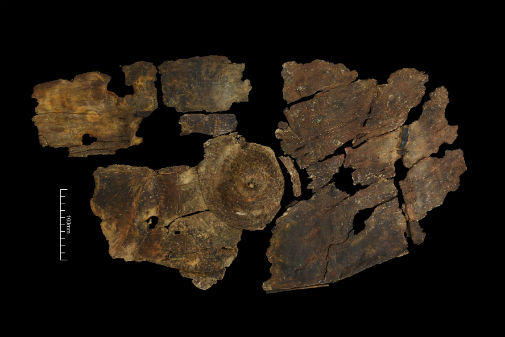Wooden Shield Dating to Iron Age Discovered in England

In Leicestershire, the only example of its kind ever found in Europe, a “surprising and unparalleled” 2,300-year-old shield made of tree bark was discovered.
Archaeologists say the discovery of the shield, made between 395 and 250BC, has completely overturned assumptions about the weapons used in the iron age, sparking breathless reactions among experts of the period.
“This is an absolutely phenomenal object, one of the most marvelous, internationally important finds that I have encountered in my career,” said Julia Farley, curator of British and European iron age collections at the British Museum.“So often it is gold which grabs the headlines, but this bark shield is much rarer.”
The shield was discovered in 2015 by archaeologists from the University of Leicester Archaeological Service in a site close to the River Soar.
Organic objects from the period very rarely survive, but the shield was preserved in waterlogged soil and may have been deposited in a water-filled pit, according to Matt Beamish, the lead archaeologist for the service.
Bark shields of the period were entirely unknown in the northern hemisphere, and the assumption was that the material may have been too flimsy for use in war. However, experiments to remake the weapon in alder and willow showed the 3mm-thick shield would have been tough enough for battle but incredibly light.
It was likely that, contrary to assumptions, similar weapons were widespread, Beamish said. The shield is made from green bark that has been stiffened with internal wooden laths, described by Beamish as “like a whalebone corset of split hardwood”, and surrounded by a rim of hazel, with a twisted willow boss.
“This is a lost technology. It has not been seen before as far as we are aware, but presumably it is a technique that was used in many ways for making bark items.”
The malleable green wood would then tighten as it dried, giving the shield its strength and forming the rounded rectangles into a slightly “waisted” shape, like a subtle figure of eight.
That was significant, said Farley, because it was exactly the shape of the ornate Battersea shield, which was dredged from the Thames in the mid-19th century and dates from the same period.“So it is possible this incredibly rare organic object is giving us some little hints about why we see what we see when we look at the metal objects.
The Battersea shield might be pretending to be a shield like this.”Because so little organic material survives from the period, she said, “we are left with the earthworks, the shiny metal work, some of the ironwork, but we don’t really see the everyday world of these people: the wooden houses they lived in with their thatched roofs, their clothing … and so really the visual world of the iron age is lost to us.
But something like this is just a little tiny window into that, which for me is fabulous and so exciting.”The shield has been donated to the British Museum where Farley said she hoped it would go on display next year.
